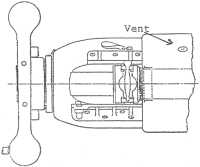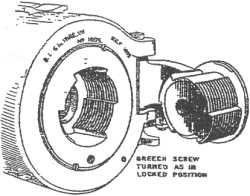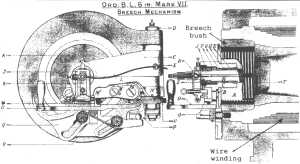The Gun - Rifled OrdnanceBreech MechanismsDespite advances made in Europe during the early 1870s Britain did not seriously consider a return to breech-loading until near the end of the decade. Demand for greater range coupled with slower-burning powders made longer barrels necessary, which in turn made the loading of RML guns more difficult particularly in the Navy. Even the conservatives began to realise that a return to breech-loading was inevitable. In his annual report for 1873-79 the Director of Artillery pointed out that owing to the increased length of guns breech-loading had become essential. Having studied the systems in use in Germany, France, and other countries, he recommended the interrupted screw, a modified version of that employed by the French. Then on 2 January 1879 a RML 12.5-inch 38-ton gun on HMS Thunderer burst, killing nine sailors and injuring 35. During a practice shoot the gun had misfired, no one had noticed, and the gun had been 'double-shotted'. Naturally, advocates of breech-loading were quick to assert that such an accident could not happen with a BL gun. In June 1879 a Committee on Ordnance was appointed to consider whether the services should have RML or BL guns - as had occurred in 1865! However, on this occasion common sense prevailed, the BL school won the day, and a programme of heavy ordnance construction was put in hand. At the same time the possibility of converting existing RBL ordnance did not escape the Committee. Although the manufacture of Armstrong RBL guns had ceased in 1864, many were still in service; New Zealand did not see the last of them until the early 1900s. As late as 1880 a proposal was made to convert the RBL 40-pr (4.75-in) and 7-inch into 'side-closing' guns by rotating the piece 90° within the trunnion ring, thus making the vent piece a horizontal sliding block. As well as making handling more convenient the conversion saved much labour, as the vent piece no longer had to be completely removed for loading. Experimental guns were prepared, other systems of obturation tried, as well as projectiles with copper driving bands (invented by Vavasseur in 1874). The modified guns were said to have 'answered extremely well' but the expense involved, especially for new ammunition ruled out further action. | |
|
Opposite: Modified breech for medium and heavy RBL guns. The vent piece has been converted to a horizontal sliding block. It no longer includes the vent, the gun has been radially vented as shown. The idea possibly came from Germany where all breeches featured a horizontal sliding block or 'wedge'.
|

|
|
The figure below shows an early BL mechanism copied from the French de Bange system of 1877 (named after Captain de Bange of the French Army who invented it in 1872).
Note: The figure on the right (B) is of a smaller gun than that on the left (A) but as the systems are identical serves to illustrate the mechanism. Early screws were comparatively long because of the amount of thread cut away which reduced their capacity to withstand firing stresses. Their length also made operation complicated, e.g. to close the breech of Fig. 122 involved four motions: swing the carrier so the screw could enter the breech, push the screw home, turn the screw through part of a turn until the threads meshed with those in the breech, lock the mechanism. Breech mechanisms of the BL 6-inch and 8-inch coast guns installed in New Zealand during the 1880s were of the type illustrated. | |
|
The long screw was superseded during the 1890s by the stepped or Welin pattern shown opposite. Whereas in the former type the effective screwed surface was half the total surface, in the latter it was two thirds, or in some cases three quarters. Being much shorter in length than the long screw the stepped version could be opened or closed by a single motion of the LBM instead of the four described for the figure above. The figure opposite shows a BL 6-in Mk 7 breech. BL 6-in Mk 7 guns were installed at Forts Cautley (North Head, Auckland), and Dorset (Wellington) in 1910. |

Welin or stepped single motion breech mechanism. |

BL 6-in Mark VII breech mechanism (click image to enlarge it)
| |
|
Note that the breech screw does not screw into the inner 'A' tube but into the breech bush which screws into the jacket. Earlier marks of BL 6-in guns were fitted with long-screw mechanisms similar to that depicted in the image above this one. All guns were fitted with percussion locks except the Mk 2 which used a simple tube holder for percussion or elementary electric tubes. The Mk 7 and later guns were fitted with 'E and PF' (electric and percussion firing) locks as shown above. As well as being employed in coast defence and the Navy the Mk 7 gun saw extensive service in the field during World War 1. For this purpose it was mounted upon a heavy siege travelling carriage drawn by a tractor and manned by Royal Garrison Artillery Gunners. The Mk 8 gun was identical to the Mk 7 except that the breech opoened to the left, ie it was designed to be 'twinned' with a Mk 7 in a Naval turret. Guns designated 'BLC' were those converted by having their breeches and breech mechanisms modified from long-screw four-motion to short-screw single-motoin. Mk 7 guns outlived some later marks; they remained in service until the abolition of coast artillery in 1956 (UK) and 1959 (NZ).
| |
WL Ruffell, 2001 |
Obturation ... |
|
previous | index | next | History index | Home | |
